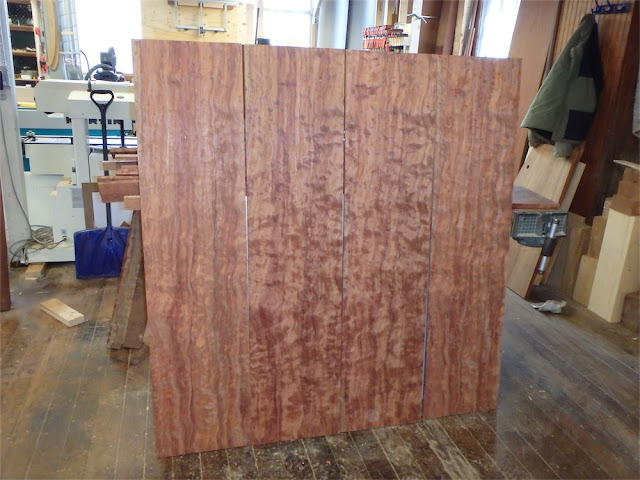While I started out with what was an enormous slab of bubinga, the sheer volume of wood does not correlate strictly with usability. I am preferentially using quartersawn or rift orientation throughout the cabinet(s), and that is where starting with a large bubinga slab afforded some options in grain selection. Once I had cut out the desired cants from the slab, I was left with a large remnant, namely the middle run of the slab. It is about 1/3 of the original width, and is a piece which was almost entirely flatsawn. A chunk like that is of far less general usefulness to me, though I do anticipate making use of it in this project. The flatsawn portion just does not convert in this case into wide pieces of stock however, just narrow and/or short pieces.
The two thick quartersawn cants I obtained from the slab were therefore precious, pretty much irreplaceable really, and it is from these two cants which I am intending to recover the panels for the doors on the cabinet. Those two doors are bifold in design, and therefore 4 panels are required. A 3" thick slab will re-saw into 4 pieces of about 0.75" in thickness, all being well. I say ‘all being well’, as this is a step carrying certain unknowns. I’ve had pieces of bubinga which, after having been re-sawn from a thicker cant, proceeded to become very unruly in their behavior and impossible to keep flat. It’s a shame to take a board which is flat and perfectly usable, then re-saw it and end up with a bunch of scrap. It just can’t be predicted what will happen, not with any certainty at least.
When re-sawing, stresses are released from the board. Some of these stresses are present as a result of the growing conditions the tree underwent, and some of these stresses may have been induced through a imperfect drying process. A piece of wood can be dead flat and look promising for re-saw, only to have boards go spriong! after cutting and you are then left with a whole bunch of nothing. It’s not a complete walk in the dark: the grain orientation of the board, along with its position in the slab, and therefore in the tree, are useful telltales as to how it might behave when sawn, and certain things can be anticipated.
In this case, having two quartersawn cants and needing to obtain 4 flat boards from each after re-sawing (given that I am making two cabinets in total) left me with no wiggle room whatsoever. No boards were permitted to move more than about 1/8" after cutting. It was verboten, and I made sure the cants were clear on this before undertaking any more work on them.
Well, in truth I did have an additional cant which was there as a back up for the panels, however I very much preferred avoiding having to cut into that spare piece since it had other vital uses on the project. I needed all the wood I can possibly convert out of the stock on hand, and as it is I had to drop another $1800 today to obtain 3 more wide quartersawn boards from Rare Earth Hardwoods in Missouri. These come on the heels of 3 long and wide bubinga boards purchased from the company last year, material which is also going into these cabinets.
These cabinets are positively going to devour material! I find it amazing how much can disappear into a piece.
In general, the safest re-saw cut is to divide a board exactly in half. This should distribute stress release equally to both pieces, and all being well, one will emerge after cutting with two flat boards. And, if the wood movement is severe after the initial division in half, then you will have a good idea of what lays ahead - i.e., more movement- and can perhaps plan accordingly. That’s a good time to head to the bar I suppose, or your wood therapist.
The initial slice and dice of the slab, detailed in the previous posting, was the first step in the process, and I let the recovered pieces sit a couple of days in my shop. No significant movement was noted, and so I proceeded to do an initial re-saw on each cant, dividing each into two boards about 1.5" thick. That also went successfully.
Today I decided, upon inspecting the re-sawn material and finding it flat, that I could tackle the next step, which was to slice each 1.5" thick piece into two boards. That process began with a pass or two on the jointer with each board:
I had meant to film the entire re-saw and the 'reveal’ afterwards, however the camera ran out of battery charge.
The resulting boards, shown at the end of the above video, are worth another look:
Can you believe this stuff?! Nature is amazing!
The set of four sawn out of the other cant:
I was greatly relieved to have obtained full value from the re-sawing, and the material looks terrific. Think how it will look once there is a finish on there….
Currently, the re-sawn material is very flat and a full ¼" over finished dimension, so I am feeling confident about having made it through this stage without incident. I was stressed but the boards were not. While in each set two of the boards appear to look really figured and two do not look quite as figured, this is simply an optical effect relating to camera position. If I shifted camera position a few inches left or right in each case, the figuring effect would shift to the other two boards in each set. It’s fun to walk along and look at the boards and see the figure shimmering about as different portions of the grain reflect.
Onward and upward…thanks for visiting.
via Tumblr http://davidpires578.tumblr.com/post/133181887584


No comments:
Post a Comment